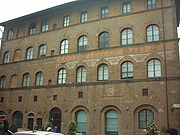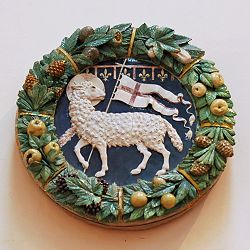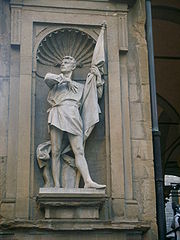
Guilds of Florence
Encyclopedia

Guild
A guild is an association of craftsmen in a particular trade. The earliest types of guild were formed as confraternities of workers. They were organized in a manner something between a trade union, a cartel, and a secret society...
s of Florence were secular corporations that controlled the arts and trades in Florence
Florence
Florence is the capital city of the Italian region of Tuscany and of the province of Florence. It is the most populous city in Tuscany, with approximately 370,000 inhabitants, expanding to over 1.5 million in the metropolitan area....
from the twelfth into the sixteenth century. These Arti included seven major guilds (collectively known as the arti maggiori), five middle guilds (arti mediane) and nine minor guilds (arti minori). Their rigorous quality control
Quality control
Quality control, or QC for short, is a process by which entities review the quality of all factors involved in production. This approach places an emphasis on three aspects:...
and the political role in the commune
Commune (intentional community)
A commune is an intentional community of people living together, sharing common interests, property, possessions, resources, and, in some communes, work and income. In addition to the communal economy, consensus decision-making, non-hierarchical structures and ecological living have become...
that the Art Maggiori assumed were formative influences in the history of Florence
History of Florence
Florence is a major historical city in Italy, distinguished as one of the most outstanding economical, cultural, political and artistic centres in the peninsula from the late Middle Ages to the Renaissance.-Prehistoric evidence:...
, which became one of the richest cities of late Medieval Europe.
The Minuto Popolo— skilled and unskilled workers including weavers, spinners, dyers, boatmen, labourers, peddlers and others—despite constituting a majority of the population, were barred from forming guilds.
Formation of the "arti"
The guildGuild
A guild is an association of craftsmen in a particular trade. The earliest types of guild were formed as confraternities of workers. They were organized in a manner something between a trade union, a cartel, and a secret society...
s were the medieval institution within which were organized every aspect of a city's economic life, forming a social network that complemented and in part compensated for family ties, although in Florence the welfare side of the guilds' activities was less than in many cities. The first of the guilds of Florence of which there is notice is the Arte di Calimala
Arte di Calimala
The Arte di Calimala, the guild of the cloth finishers and merchants in foreign cloth, was one of the greater guilds of Florence, the Arti Maggiori, who arrogated to themselves the civic power of the Republic of Florence during the Late Middle Ages...
, the cloth-merchants' guild, mentioned in a document of about 1150. By 1193 there existed seven such corporate bodies, which each elected a council whose members bore the Roman-sounding designation consoli
Consul
Consul was the highest elected office of the Roman Republic and an appointive office under the Empire. The title was also used in other city states and also revived in modern states, notably in the First French Republic...
. A single capo was elected to manage all the business of the guild.
Entrance to the Arti was highly structured from the first records; it was necessary to be the legitimate son of a member, to give proofs of competence in the craft involved, and to pay an entrance tax. Masters of the guilds, who possessed the means of production, took on apprentices and garzoni, the "boys" or journeymen who might work through a long career without ever becoming a master.

Piazza della Signoria
Piazza della Signoria is an L-shaped square in front of the Palazzo Vecchio in Florence, Italy. It was named after the Palazzo della Signoria, also called Palazzo Vecchio....
, befitting the controlling role of the Arti in governing Florence.
As elsewhere, the guilds of Florence protected its members from competition within the city by strangers and Florentine outsiders, guaranteed the quality of work through strict supervision of the workshops (botteghe), stipulated work hours, established markets and feast days, and provided public services to its members, and their wives, widows and children. During the fifteenth century city watchmen were organized by the Arti to protect closed workshops and warehouses.
From the beginning, not all arti were equal: to the original seven Arti Maggiori were added fourteen Arti Minori as the guild system spread.
Role in government
Six of the nine Priori of the Signoria of FlorenceSignoria of Florence
The Signoria was the government of medieval and renaissance Florence. Its nine members, the Priori, were chosen from the ranks of the guilds of the city: six of them from the major guilds, and two from the minor guilds...
were selected from the major guilds, and two were selected by the minor guilds.
The first scheduled list of Guilds, including twenty-one, appared in 1236. The second scheduled list of Guilds, differentiating seven "Greater" and fourteen "Lesser" Guilds, appeared in 1266. That same year the
consuls of the seven "Greater" Guilds became the "Supreme Magistrate of the State". The first five of the "Lesser Guilds" were
designated "Intermediate Guilds" (Arte Mediane) in 1280, when the Signoria first assumed office, and their consults were admitted to the
conferences of the consuls of the seven "Greater" Guilds.
In 1282, three "Priors of the Guilds" were elected, with powers only inferior to the Chief-Magistrate of the State. The
third scheduled list of guilds, finalizing their order of precedence
Order of precedence
An order of precedence is a sequential hierarchy of nominal importance of items. Most often it is used in the context of people by many organizations and governments...
appeared the following year. The nine lowest guilds
were allotted banners and coats-of-arms in 1291.
A General Code, "Il Statuto", for the guilds was promulgated in 1296 with the founding of the Corte della Mercanzia. The Statutes of all the guilds underwent a complete revision between 1301 and 1307, and the "New Code" was first adopted by the Calimala; the statutes were again revised in 1386.
Three new operative guilds were formed in 1378 after the Ciompi
Ciompi
The Revolt of the Ciompi was a popular revolt in late medieval Florence by wool carders known as ciompi , who rose up in 1378 to demand a voice in the commune's ordering....
revolt. The fourth scheduled
list of guilds, appearing in 1415, however, still included only twenty-one guilds. The Grandi attempted in
1427 to reduce the "Lesser" guilds to only seven. Indeed, in 1534, the fourteen "Lesser" guilds were arranged in four
Universities, and saw many of their privileges curtailed.
Arti maggiori
| Major Guild | Symbol | Patronage | Founding | Notes |
|---|---|---|---|---|
| Arte di Calimala Arte di Calimala The Arte di Calimala, the guild of the cloth finishers and merchants in foreign cloth, was one of the greater guilds of Florence, the Arti Maggiori, who arrogated to themselves the civic power of the Republic of Florence during the Late Middle Ages... |
 |
Workers in wool, cloth merchants | Circa 1190 | Suppressed in 1770 by Pietro Leopoldo, Grand Duke of Tuscany Leopold II, Holy Roman Emperor Leopold II , born Peter Leopold Joseph Anton Joachim Pius Gotthard, was Holy Roman Emperor and King of Hungary and Bohemia from 1790 to 1792, Archduke of Austria and Grand Duke of Tuscany from 1765 to 1790. He was a son of Emperor Francis I and his wife, Empress Maria Theresa... |
| Arte della Lana Arte della Lana The Arte della Lana was the wool guild of Florence during the Late Middle Ages and in the Renaissance. It was one of the seven greater Arti of Florence, separate from the Arti Minori... |
 |
Wool merchants | Pre-1192 | Took charge of Santa Maria del Fiore in 1282 |
| Arte dei Giudici e Notai |  |
Judges, lawyers, and notaries | 1197 | Listed first among the "Twelve Greater Guilds" on a 1282 list currently at the British Museum British Museum The British Museum is a museum of human history and culture in London. Its collections, which number more than seven million objects, are amongst the largest and most comprehensive in the world and originate from all continents, illustrating and documenting the story of human culture from its... ; Abolished in 1597, the same year a "College of Judges and Notaries" was incorporated. |
| Arte del Cambio |  |
Bankers | Pre-1197 | |
| Arte della Seta Arte della Seta The Arte della Seta was the silk guild of Florence during the Late Middle Ages and in the Renaissance. It was one of the seven greater Arti of Florence, separate from the Arti Minori .... |
 |
Silk weavers | Pre-1192 | Included bronze sculptors |
| Arte dei Medici e Speziali |  |
Physicians and pharmacists | 1197 | Included painters from 1314, and as an independent branch from 1378; also included shopkeepers who sold spices, dyes, and medicines |
| Arte dei Vaiai e Pellicciai |  |
Furriers | 1197 |
Arti mediane
| Middle Guild | Symbol | Patronage | Founding | Notes |
|---|---|---|---|---|
| Arte dei Beccai |  |
Graziers | Circa 1236 | First of the five intermediate guilds |
| Arte dei Calzolai |  |
Shoemakers | Pre-1236 | |
| Arte dei Fabbri |  |
Iron workers | Pre-1236 | |
| Arte dei Maestri di Pietra e Legname |  |
Workers in stone and wood | Pre-1236 | Included sculptors |
| Arte dei Linaioli e Rigattieri | Workers of flax, tailors | 1266 |
Arti minori
| Minor Guild | Symbol | Patronage | Founding | Notes |
|---|---|---|---|---|
| Arti dei Vinattieri | Wine | 1266 | ||
| Arti degli Albergatori | Innkeepers | 1282 | Cleaved from the Vinattieri in 1282 | |
| Arti dei Oliandoli e Pizzicagnoli | Millworkers | Pre-1236 | Arte de' Galigai renamed Arte degli Oliandoli in 1415; missing in the 1282 and 1295 lists of guilds, replaced by the "Arti dei Venditori del Sale". | |
| Arti dei Cuoiai e Galigai | Leather workers | 1282 | ||
| Arti dei Corazzai e Spadai |  |
Armourers | Pre-1236 | |
| Arti dei Correggiai | Military leather workers (e.g. Saddlers) | Pre-1236 | ||
| Arti dei Legnaioli |  |
Wood | Pre-1236 | |
| Arti dei Chiavaioli |  |
Keymakers | ||
| Arti dei Fornai | Bakers | Pre-1236 | Regarded as the seventh of fourteen lesser guilds in 1236; lowest in the order of precedence since 1282 |
Artists
In Florence a separate Guild of Saint LukeGuild of Saint Luke
The Guild of Saint Luke was the most common name for a city guild for painters and other artists in early modern Europe, especially in the Low Countries. They were named in honor of the Evangelist Luke, the patron saint of artists, who was identified by John of Damascus as having painted the...
for artists did not exist. Painters belonged to the guild of the Doctors and Apothecaries ("Arte dei Medici e Speziali") as they bought their pigments from the apothecaries, while sculptors were members of the Masters of Stone and Wood ("Maestri di Pietri e Legname), or the metalworkers if working in that medium. They were also frequently members in the confraternity of St. Luke (Compagnia di San Luca)—which had been founded as early as 1349—although it was a separate entity from the guild system. In the sixteenth century, the Compagnia di San Luca began to meet at SS. Annunziata
Basilica della Santissima Annunziata di Firenze
The Basilica della Santissima Annunziata is a Roman Catholic minor basilica in Florence, Italy, the mother church of the Servite order. It is located at the northeastern side of the Piazza Santissima Annunziata....
, and sculptors, who had previously been members of a confraternity dedicated to St. Paul (Compagnia di San Paolo), also joined. This form of the compagnia developed into the Florentine Accademia e Compagnia delle arti del Disegno
Accademia delle Arti del Disegno
The Accademia delle Arti del Disegno of Florence promotes the safeguard of the works of art in Italy. Founded in 1563, it was the first academy of drawing established in Europe.- History of the Accademia :...
in 1563, which was then formally incorporated into the city's guild system in 1572.
The guilds were important patrons of the arts. The statues of the Orsanmichele
Orsanmichele
Orsanmichele is a church in the Italian city of Florence...
were a lavish joint, and highly competitive, effort, the Calimala were responsible for the Baptistry and paid for Ghiberti
Lorenzo Ghiberti
Lorenzo Ghiberti , born Lorenzo di Bartolo, was an Italian artist of the early Renaissance best known for works in sculpture and metalworking.-Early life:...
's famous doors, while the Lana were responsible for the cathedral itself, and paid for the cupola
Cupola
In architecture, a cupola is a small, most-often dome-like, structure on top of a building. Often used to provide a lookout or to admit light and air, it usually crowns a larger roof or dome....
, the altar frontal and other works, and the Seta built and ran the Ospedale degli Innocenti
Ospedale degli Innocenti
The Ospedale degli Innocenti is a historical building in Florence, central Italy. Designed by Filippo Brunelleschi, who received the commission in 1419, it was originally a children's orphanage. It is regarded as a notable example of early Italian Renaissance architecture...
See also

- CiompiCiompiThe Revolt of the Ciompi was a popular revolt in late medieval Florence by wool carders known as ciompi , who rose up in 1378 to demand a voice in the commune's ordering....
, guild-less wool carders who revolted in 1378

